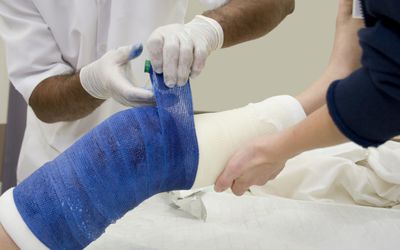- drmrs75@gmail.com
- +91 8080640148 | +91 8692962726

FRACTURE CARE
A fracture is a full or partial break in the continuity of bone. There are several different ways in which a bone can fracture. For example, a closed fracture is a break to the bone that does not damage surrounding tissue or tear through the skin. By contrast, a compound fracture is one that damages surrounding tissue and penetrates the skin. Compound fractures are generally more serious than simple fractures due to the risk of infection.
Symptoms
Symptoms of a fracture vary depending on its location, a person’s age and general health, and the severity of the injury.
However, people with a bone fracture will typically experience some of the following:
Pain
Swelling
Bruising
Discolored skin around the affected area
Inability to put weight on the injured area
Inability to move the affected area
A grating sensation in the affected bone or joint
Bleeding if it is an open fracture
Causes
Healthy bones are extremely resilient and can withstand surprisingly powerful impacts. However, under enough force, they may crack or break.
Physical trauma, overuse, and health conditions that weaken the bones, such as osteoporosis, are the leading causes of bone fractures.
Diagnosis and treatment
The doctor will inquire about the circumstances that led to a person’s fracture. They will then carry out a physical examination to reach a diagnosis.
Often, the doctor will order an X-ray, and in some cases, an MRI or CT scan, to fully assess the fracture.
Bone healing is a natural process, in most cases, will occur naturally. Therefore, treatment typically focuses on providing the injured bone with the best circumstances for healing, and ensuring optimal future function.
For the natural healing process to begin, doctor will reduce the fracture. This involves lining up the ends of the broken bones. In smaller fractures, doctor can do this by manipulating the affected area externally. However, in some instances, this may require surgery.
Once doctor has aligned the fracture, they will ensure it stays in place. Methods of doing so includes:
Casts or braces
Metal plates and screws
Intramedullary nails, k wires, etc
External fixators
Fractures can take several weeks to several months to heal, depending on their severity. The duration is contingent on which bone has become affected and whether there are any complications, such as a blood supply problem or an infection.
Other factors that can affect bone healing include:
Smoking
Excessive alcohol consumption
A high body mass index
After the bone has healed, it may be necessary to restore muscle strength and mobility to the affected area through physical therapy.
If the fracture occurs near or through a joint, there is a risk of stiffness or osteoarthritis.
Prevention
A person can reduce their risk of bone fractures through a number of remedies and lifestyle changes.
A person’s diet can affect their risk of fractures. The human body needs adequate supplies of calcium for healthy bones. Milk, cheese, yogurt, and dark green leafy vegetables are good sources of calcium.
The body also requires vitamin D to absorb calcium. Exposure to sunlight and eating eggs and oily fish are good ways of getting vitamin D.
Engaging in weight-bearing exercise can help improve muscle mass and bone density. Both of these can reduce the risk of bone fractures.
Research has shown that regular exercise and a balanced diet can reduce the risk of a fracture in people with osteoporosis.
Moreover, levels of estrogen, which plays a role in bone health, drop substantially during menopause. This makes calcium regulation more difficult and increases the risk of osteoporosis and fractures.
Consequently, people need to be particularly careful about the density and strength of their bones during and after menopause.